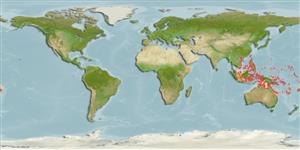Common names from other countries
>
Eupercaria/misc (Various families in series Eupercaria) >
Scaridae (Parrotfishes) > Scarinae
Etymology: Chlorurus: Greek, chloros = green + Greek oura = tail (Ref. 45335).
Environment: milieu / climate zone / depth range / distribution range
Écologie
marin récifal; profondeur 0 - 35 m (Ref. 90102), usually 5 - 25 m (Ref. 9793). Tropical; 21°N - 25°S, 104°E - 174°W
Indo-Pacific: East Indian region to Micronesia, Samoa, and Fiji and Philippines to Australia; throughout East Indian region except Andaman Sea.
Taille / Poids / Âge
Maturity: Lm ? range ? - ? cm
Max length : 49.0 cm TL mâle / non sexé; (Ref. 9710)
Description synthétique
Clés d'identification | Morphologie | Morphométrie
Épines dorsales (Total) : 9; Rayons mous dorsaux (Total) : 10; Épines anales: 3; Rayons mous anaux: 9. This species is distinguished by the following characters: median predorsal scales 5-7 (usually 6); 2 scale rows on cheek, 1(6-8), 2(6-8); pectoral-fin rays 15; dental plates well exposed, lips not covering the plates; 1-2 conical teeth on side of upper dental plate; caudal fin truncate. Colour of initial phase (IP) dark brown with broad pale bars on sides and pale caudal fin and caudal peduncle; male with greenish large pale cream patch below eye bordered entirely by a thick green line. Male greenish with pink scale edges, green central zone and outer margins on tail and large rectangular whitish area on cheek; female dark brown with 3-4 broad pale bars (Ref. 9793, 90102, 117228).
Found in clear coastal and inner reefs (Ref. 48636); in lagoons and channel reefs (Ref. 2334). Feeds by scraping algae from the substrate (Ref. 26993). Females usually in small groups and maybe mixed with other species when feeding; males solitary nearby (Ref. 48636). Minimum depth reported taken from Ref. 128797.
Life cycle and mating behavior
Maturities | Reproduction | Spawnings | Egg(s) | Fecundities | Larves
Oviparous, distinct pairing during breeding (Ref. 205).
Randall, J.E., G.R. Allen and R.C. Steene, 1990. Fishes of the Great Barrier Reef and Coral Sea. University of Hawaii Press, Honolulu, Hawaii. 506 p. (Ref. 2334)
Statut dans la liste rouge de l'IUCN (Ref. 130435)
CITES (Ref. 128078)
Not Evaluated
Menace pour l'homme
Harmless
Utilisations par l'homme
Pêcheries: intérêt commercial mineur; Aquarium: Commercial
Outils
Articles particuliers
Télécharger en XML
Sources Internet
Estimates based on models
Preferred temperature (Ref.
115969): 25.8 - 29.3, mean 28.6 (based on 1692 cells).
Phylogenetic diversity index (Ref.
82804): PD
50 = 0.5000 [Uniqueness, from 0.5 = low to 2.0 = high].
Bayesian length-weight: a=0.02754 (0.01419 - 0.05347), b=3.01 (2.83 - 3.19), in cm Total Length, based on LWR estimates for this species & (Sub)family-body (Ref.
93245).
Niveau trophique (Ref.
69278): 2.0 ±0.00 se; based on food items.
Résilience (Ref.
120179): Milieu, temps minimum de doublement de population : 1,4 à 4,4 années (Preliminary K or Fecundity.).
Fishing Vulnerability (Ref.
59153): Moderate vulnerability (39 of 100).
